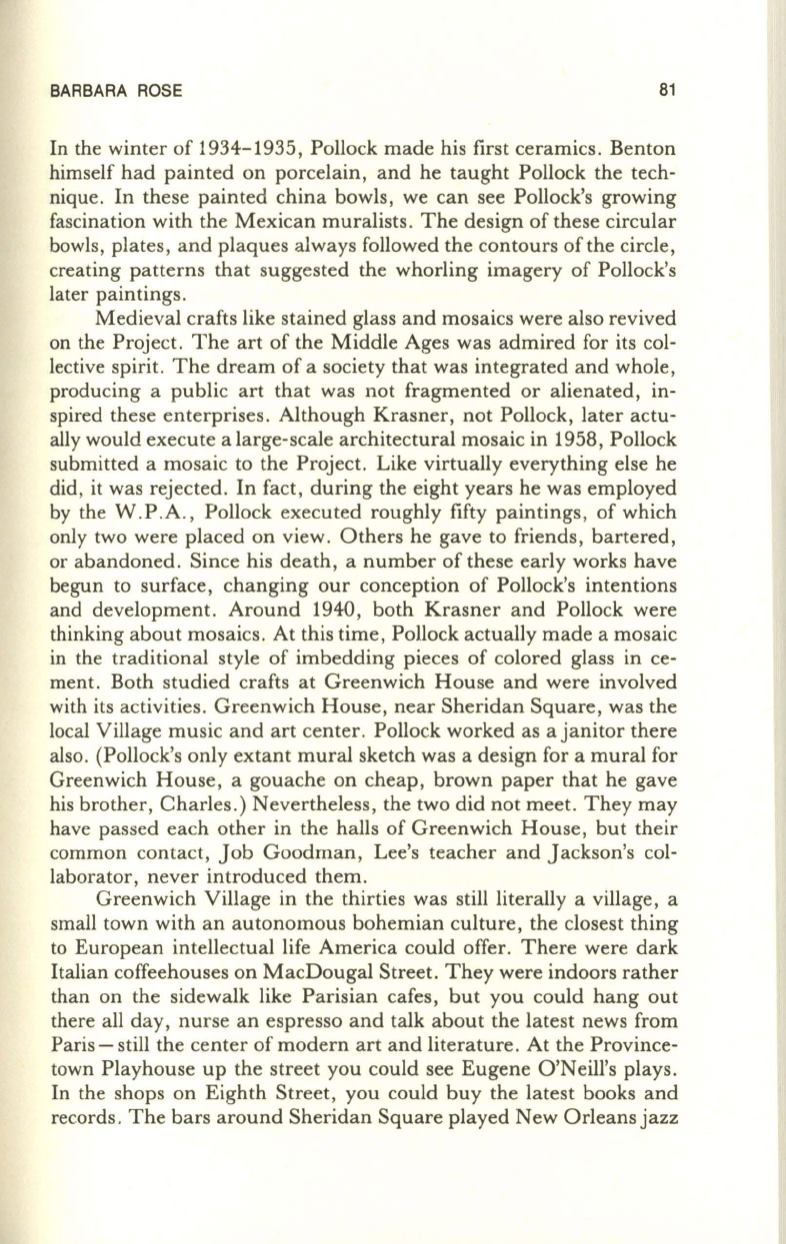
BARBARA ROSE
81
In the winter of 1934-1935, Pollock made his first ceramics . Benton
himself had painted on porcelain, and he taught Pollock the tech–
nique. In these painted china bowls, we can see Pollock's growing
fascination with the Mexican muralists. The design of these circular
bowls, plates , and plaques always followed the contours of the circle,
creating patterns that suggested the whorling imagery of Pollock's
later paintings .
Medieval crafts like stained glass and mosaics were also revived
on the Project. The art of the Middle Ages was admired for its col–
lective spirit. The dream of a society that was integrated and whole,
producing a public art that was not fragmented or alienated, in–
spired these enterprises. Although Krasner, not Pollock, later actu–
ally would execute a large-scale architectural mosaic in 1958, Pollock
submitted a mosaic to the Project. Like virtually everything else he
did, it was rejected . In fact, during the eight years he was employed
by the W .P.A., Pollock executed roughly fifty paintings, of which
only two were placed on view. Others he gave to friends, bartered,
or abandoned . Since his death, a number of these early works have
begun to surface, changing our conception of Pollock's intentions
and development. Around 1940, both Krasner and Pollock were
thinking about mosaics. At this time, Pollock actually made a mosaic
in the traditional style of imbedding pieces of colored glass in ce–
ment. Both studied crafts at Greenwich House and were involved
with its activities. Greenwich House, near Sheridan Square, was the
local Village music and art center. Pollock worked as a janitor there
also. (Pollock's only extant mural sketch was a design for a mural for
Greenwich House, a gouache on cheap, brown paper that he gave
his brother, Charles.) Nevertheless, the two did not meet . They may
have passed each other in the halls of Greenwich House, but their
common contact, Job Goodman, Lee's teacher and Jackson's col–
laborator, never introduced them.
Greenwich Village in the thirties was still literally a village, a
small town with an autonomous bohemian culture, the closest thing
to European intellectual life America could offer. There were dark
Italian coffeehouses on MacDougal Street. They were indoors rather
than on the sidewalk like Parisian cafes, but you could hang out
there all day, nurse an espresso and talk about the latest news from
Paris - still the center of modern art and literature . At the Province–
town Playhouse up the street you could see Eugene O'Neill's plays.
In the shops on Eighth Street, you could buy the latest books and
records . The bars around Sheridan Square played New Orleans jazz


